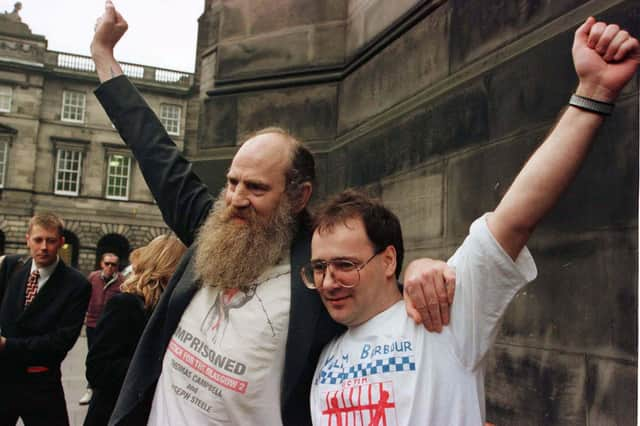The aftermath of the Ice Cream war - reflecting on the protests, appeals and victories


It was the morning of April 16, 1984, a fire engulfed the family home of Bankend Street, Ruchazie. The tragedy would lead to one of the biggest profile miscarriages we’ve seen in Scottish legal history.
Petrol had been poured on the third-floor flat on the doorstep and the letter box before setting fire to the whole flat.
Advertisement
Hide AdAdvertisement
Hide AdSix members of the Doyle family died in the aftermath of the fire - Andrew Doyle, one of the victims was a young ice cream van driver who had, in the weeks running up to his death, received threats and intimidation. The police would quickly link the fire to organised criminal gangs trying to muscle in on the city’s ice cream trade.
Rival ice cream firms were battling for dominance at the lucrative East End schemes, vendors were fiercely territorial and often got into altercations including 50 ices who hired vans to Thomas ‘TC’ Campbell.
For more than 17 years, Campbell and Joe Steele denied responsibility for that arson attack. They had been immediately arrested following pressure from the public and politicians before being jailed for life for imprisonment.
Campbell and Steele pleaded their innocence and campaigned tirelessly for their release, after nine years and one appeal, they were nowhere close to a conclusion.
Advertisement
Hide AdAdvertisement
Hide AdIn 1993, Campbell released a video to the press saying, “From the condemnation of the innocent man, flows the acquittal of the guilty man.”
This wasn’t the only form of protest, Campbell wrote letters to politicians and staged hunger strikes.
Steele in the same year staged various escapes out of prison including a surveillance tower outside Barlinnie Prison in Glasgow. A petition was only formed with only two people refusing to sign out of 3,000 people.
The protests kept on coming which changed a lot of people’s perceptions. In 1996, both Campbell and Steele were freed on bail awaiting an appeal.
Advertisement
Hide AdAdvertisement
Hide AdA year later, the appeal began, and both men were confident prior to the hearing but the outcome was refused by Lord Cullen.
Then on December 12, 2001, Campbell and Steele emerged from the Appeal Court in Edinburgh and took their first breath of freedom after searching every avenue to find a resolution.
Satisfaction at the outcome was absolute but incensed and subdued by the memory of their previous bid for justice five years previously which saw them sent back to prison after only a year.
As they emerged from court, the pair walked on to the Royal Mile, calmly raising their fists in defiance as the cheers of their supporters echoed around Parliament Square.
Advertisement
Hide AdAdvertisement
Hide AdThey addressed the crowd, and not a hint of confidence came out of their mouths when making speeches - they both knew the system too well and the scars of their run-ins with justice now clearly run far too deep.
A conclusion and resolution had been met - it meant having to circumvent but it was done in a clever and surreptitious way - it started off internally before the attention got more widespread and constructive and a positive outcome had finally been achieved and both Campbell and Steele got to spend Christmas with their families after spending far too long apart for their liking.
More information on the final court case can be found here - catch the last episode on BBC IPlayer
Comment Guidelines
National World encourages reader discussion on our stories. User feedback, insights and back-and-forth exchanges add a rich layer of context to reporting. Please review our Community Guidelines before commenting.